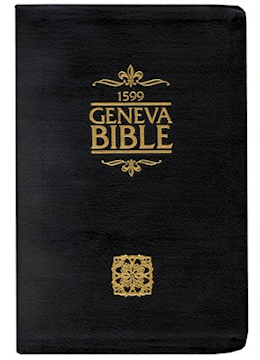Textus Receptus Bibles
Geneva Bible 1560/1599
| 27:1 | And Dauid said in his heart, I shall now perish one day by the hand of Saul: is it not better for me that I saue my selfe in the lande of the Philistims, and that Saul may haue no hope of me to seeke me any more in all the coastes of Israel, and so escape out of his hand? |
| 27:2 | Dauid therefore arose, and he, and the sixe hundreth men that were with him, went vnto Achish the sonne of Maoch King of Gath. |
| 27:3 | And Dauid dwelt with Achish at Gath, he, and his men, euery man with his housholde,Dauid with his two wiues, Ahinoam the Izreelite, and Abigail Nabals wife the Carmelite. |
| 27:4 | And it was tolde Saul that Dauid was fled to Gath: so he sought no more for him. |
| 27:5 | And Dauid saide vnto Achish, If I haue nowe founde peace in thine eyes, let them giue me a place in some other citie of the countrey, that I may dwell there: for why should thy seruant dwel in ye head citie of the kingdome with thee? |
| 27:6 | Then Achish gaue him Ziklag that same day: therefore Ziklag pertaineth vnto the kings of Iudah vnto this day. |
| 27:7 | And the time that Dauid dwelt in the countrey of the Philistims, was foure moneths and certaine dayes. |
| 27:8 | Then Dauid and his men went vp, and inuaded the Geshurites, and the Girzites, and the Amalekites: for they inhabited the lande from the beginning, from the way, as thou goest to Shur, euen vnto the lande of Egypt. |
| 27:9 | And Dauid smote the lande, and left neither man nor woman aliue, and tooke sheepe, and oxen, and asses, and camels, and apparell, and returned and came to Achish. |
| 27:10 | And Achish said, Where haue ye bene a rouing this day? And Dauid answered, Against the South of Iudah, and against the South of the Ierahmeelites, and against the South of ye Kenites. |
| 27:11 | And Dauid saued neither man nor woman aliue, to bring them to Gath, saying, Lest they should tel on vs, and say, So did Dauid, and so will be his maner all the while that he dwelleth in the countrey of the Philistims. |
| 27:12 | And Achish beleeued Dauid, saying, He hath made his people of Israel vtterly to abhorre him: therefore he shalbe my seruant for euer. |

Geneva Bible 1560/1599
The Geneva Bible is one of the most influential and historically significant translations of the Bible into English, preceding the King James translation by 51 years. It was the primary Bible of 16th century Protestantism and was the Bible used by William Shakespeare, Oliver Cromwell, John Knox, John Donne, and John Bunyan. The language of the Geneva Bible was more forceful and vigorous and because of this, most readers strongly preferred this version at the time.
The Geneva Bible was produced by a group of English scholars who, fleeing from the reign of Queen Mary, had found refuge in Switzerland. During the reign of Queen Mary, no Bibles were printed in England, the English Bible was no longer used in churches and English Bibles already in churches were removed and burned. Mary was determined to return Britain to Roman Catholicism.
The first English Protestant to die during Mary's turbulent reign was John Rogers in 1555, who had been the editor of the Matthews Bible. At this time, hundreds of Protestants left England and headed for Geneva, a city which under the leadership of Calvin, had become the intellectual and spiritual capital of European Protestants.
One of these exiles was William Whittingham, a fellow of Christ Church at Oxford University, who had been a diplomat, a courtier, was much traveled and skilled in many languages including Greek and Hebrew. He eventually succeeded John Knox as the minister of the English congregation in Geneva. Whittingham went on to publish the 1560 Geneva Bible.
This version is significant because, it came with a variety of scriptural study guides and aids, which included verse citations that allow the reader to cross-reference one verse with numerous relevant verses in the rest of the Bible, introductions to each book of the Bible that acted to summarize all of the material that each book would cover, maps, tables, woodcut illustrations, indices, as well as other included features, all of which would eventually lead to the reputation of the Geneva Bible as history's very first study Bible.